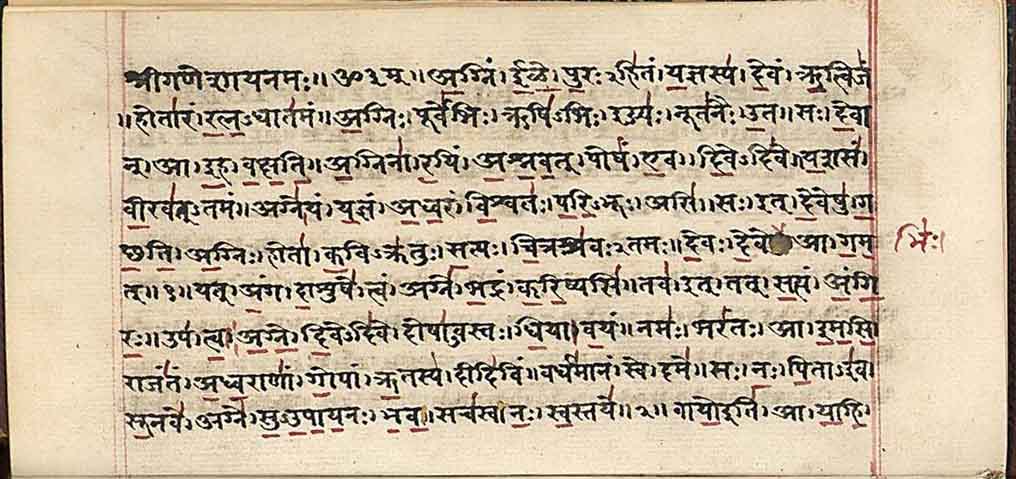
The statement that the Rigveda is the oldest known text and one of the oldest Vedas is very well known. However, an important distinction between the Rigveda and any other text of antiquity whether older than the Rigveda or its contemporary is that the Rigveda was never lost. This uninterrupted use for many millennia gives the Rigveda its unique position. It was and still is a part of the living tradition. In that sense, the Vedas are certainly immortal.
The significance of the name Rigveda
The name is made up of two terms: ṛc ‘mantra or stanza expressing praise’ and veda meaning ‘knowledge’. The terms that are used in connection to the Vedas are technical and important and very often also help identify which of the Vedas is being spoken about. For instance, the word rig or ṛc ; itself signifies that it is a laudatory stanza and should belong to the Rigveda. The word yajus also stands for stanza but the connotation is of a formula related to sacrifices (यज्ञ). However, there occur many instances of over lapping of content in all four of the Vedas.
The format of the Rigveda
The Rigveda contains 1028 hymns or suktas. They are again technical terms for what can be loosely described as songs. But these are not typical songs as they may follow a metre but not necessarily a rhyme.
The arrangement of the hymns in the Rigveda is truly fascinating as it is very clearly an artificial arrangement but an historical one. The hymns are divided into ten ‘Books’ or ten ‘Maṇḍalas’ as they are called. The term Maṇḍala for a chapter or division is only used in connection to the Rigveda and not any other Veda.
All the books are of varying length except for the first and the tenth, which have the same number of hymns; 191. Books Two to Eight are referred to as the ‘Family Books’ or ‘Kula Maṇḍalas’, (मण्डल) as each book is named after a specific seer or ṛṣi (ऋषि). It points to a tradition of a family or school where the hymns are seen or heard by the same poet and handed down as heritage. The different family lineages are:
II – Gr̥tsamada (गृत्समद)
III – Viśvāmitra (विश्र्वामित्र)
IV – Vāmadeva (वामदेव)
V – Atri (अत्रि)
VI – Bharadvāja (भारद्वाज)
VII – Vasiṣṭha (वशिष्ठ)
The eighth maṇḍala is not strictly a family book, but is identified with the names of two seers whose hymns appear predominantly in the book rather than exclusively.
VIII- Kāṇva – Āṅgirasa (कण्व – अंगिरस)
These are the sages who ‘saw’ or ‘heard’ the hymns and Veda Vyasa is traditionally considered as the compiler of all the Vedas.
Book Nine is unusual as it is not attested to a seer but to a deity. The deity of the hymns is Soma, the drink. In fact, the maṇḍala is referred to as Pavamāna Soma, which means the soma which is in the process of clarification. The use of Soma and the process of clarification was an important ritual by itself in the bigger scheme of the sacrificial rituals in the Vedic period.
Books one and ten are considered younger than the other books and both contain a mix of hymns related to different subjects. Though it is Book ten which has the most number of philosophical and secular hymns.

Subject matter of the hymns in the Rig Veda
- The most common are the hymns to praise the gods. In many cases to show the power and quality of the gods, various deeds were attributed to them and the episode recounted in the hymns. What is exceptional is that specific hymns were sung for specific purposes or needs of the people. The hymns were not sung randomly, but had a sense of purpose attached to them.
- There are dialogue or narrative hymns which are in the form of a dialogue taking place between two people (including divine and semi divine beings) and in one case between a river and a sage.
- Creation, cosmological and philosophical hymns. They question the beginning of the universe and have diverse belief systems and theories. Some of the most famous are the Puruṣa Sukta, Nāsadīya Sukta, Hiraṇyagarbha Sukta.
- Secular hymns; that is those which do not have a religious purpose. The famous Akṣasukta (The gambler’s hymn) occurs here.
- Funeral and marital hymns.
The above is only a broad spectrum classification and there maybe a few hymns that may fall outside of the above categories.
To summarise, the Rigveda is a compilation of hymns in praise of the deities divided into different books in order of the significance of the deity and placed together with other hymns from the pen of the same poet or school.
References:
Gonda, Jan. A History of Indian Literature Vol I (Vedic Literature), Wiesbaden, Otto Harrassowitz, 1975
Talageri, Shrikant. The Rigveda, A Historical Analysis, New Delhi, Aditya Prakashan, 2000
Jamison, Stephanie W. and Brereton, Joel P. The Rigveda, The Earliest Religious Poetry of India Vol III, New York, Oxford University Press, 2014
Ṛgvedasaṁhitā with the Commentary of Sāyaṇāchārya Vol III,Vaidika Samshodhana Maṇḍala, Tilak Maharashtra Vidyapeeth, Poona, 1941
Satavalekar, Shripad Damodar. Ṛgvedakā Subodh Bhāṣya, Paradi, Svadhyaya Maṇḍala, 2000


Add comment